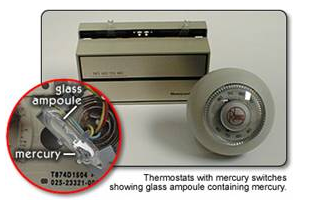Apr 18
2013
NY’s toxic disposal of mercury thermostats

New York has a dismal record when it comes to collecting thermostats that contain mercury and legislation that might help hasn’t passed both chambers for years.
The result is that these toxic thermostats end up in landfills and leach into land and water—nearly a ton of mercury annually in New York alone.
Keeping mercury out of landfills and the environment is important because it is a toxic pollutant that can make fish inedible and cause brain and liver damage, along with behavioral and developmental problems in children and fetuses.
The EPA conducted a study in 2004 that found more than 10 percent of the mercury reservoir in the country is in old thermostats.
In 2004, the state banned the sale of mercury-containing thermometers and other items. The following year it phased out the sale of mercury-containing consumers products, which included thermostats, switches and measuring devices. The state also banned the disposal of mercury-containing items at solid waste plants. But lawmakers didn’t consider how to collect these items.
Violators are warned on first offense; they can subsequently be fined anywhere from $50 for a second offense to $100 for a fourth offense.
The possibility of fines don’t appear to be much of a deterrent: each year, approximately 306,000 mercury-containing thermostats still end up in landfills or at incinerators.
New York has 10 waste-to-energy incinerators. They released 128 pounds of mercury into the air in 2009, according to the state Department of Environmental Conservation. The closest waste-to-energy incinerator to Buffalo is Covanta Niagara, which released 34 pounds of mercury in 2009, the most of any incinerator in the state that year.
Covanta Niagara has released less mercury since then: 28 pounds in 2010 and 13 pounds in 2011.
Keep in mind that only coal plants have to regularly monitor mercury emissions, so the reporting from these incinerators is an average that reflects only a small amount of testing during the year.
New York collects only 1.8 thermostats with mercury per 10,000 residents. That’s 3,422 thermostats in 2011, which ranks 37th in the country on a per capita basis, according to a study released this month called “Turning up the Heat II.”
“In the absence of an effective collection program, nearly 99 percent of mercury-containing thermostats discarded in New York end up in landfills or incinerators, despite the ban on such disposal,” said Laura Haight of the New York Public Interest Research Group, a research and advocacy organization.
Iowa, Nebraska, Michigan, Wisconsin and Pennsylvania did 10 to 20 times better than New York on a per capita basis.
No. 1 Vermont collected 57.2 thermostats per 10,000 residents.
Senator Mark Grisanti, chairman of the Environmental Conservation Committee, proposed legislation again this year that would create a mandatory collection program for mercury-containing thermostats. Similar legislation has failed for several straight years.
Although the legislation isn’t as tough as the one Maine passed in 2006, it would require manufacturers to establish and maintain a collection program for out-of-service mercury-containing thermostats and to manage these programs. Thermostat manufactures would have to publish annual reports of its collection program, but the proposed legislation falls short from enacting any penalty for any manufacture that does not meet statewide collection goals.
The Maine law requires manufacturers to offer a minimum $5 incentive to any person or contractor who disposes of a mercury-containing thermostat at their collection facilities.
Grisanti’s legislation does not require any incentive. If manufactures are not meeting collection goals, the DEC would have stakeholder meetings to work on modifying their collections programs. If DEC determines the modifications won’t be enough, it can only require the $5 incentive program for contractors and consumers .
“We feel the bill will be robust enough to achieve the collection goals without imposing a bounty upfront,” said Daniel R. Schlesinger, Grisanti’s counsel to the Environmental Conservation Committee.
Grisanti’s bill also proposes penalties not to exceed $500 per day for any manufacture that violates provisions of the bill.
“Our aim is not to punish manufacturers for failing to meet the goals despite their compliance with all sections of the law,” Schlesinger said.
Haight said Assemblyman Robert K. Sweeney has a stronger proposal that would require incentives by 2018 if goals are not met.

